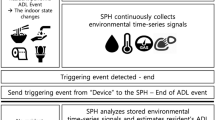Abstract
This work reports the development and evaluation of a robust and easily deployable soap use logging device. The waterproof device contains motion and sound sensors and can be fully embedded in commercial bar soap. At rest, the device is in a low-power mode and the recording of data is triggered by vibrations measured by a tilt switch. Monitoring soap usage is used to support behaviour change interventions, with the aim to reduce contact diseases. Following the algorithm development under laboratory conditions, we evaluate the performance of the logging device under free-living conditions in 58 low-income households in India. In addition to the measurement by logger soaps, washing activity was recorded by observers. These data allow us to quantify the error of soap use detection. Further, the study data are used to train and evaluate an algorithm for the discrimination of soap use associated with hand and body wash. The results show that the soap logger provides an unobtrusive and objective measure of free-living soap usage. The analysis of the activity features reveals a novel hygienic habit, which is important information for the design of bespoke interventions.









Similar content being viewed by others
References
Zillmer R (2007) Measurement of toothbrushing behaviour in a natural environment. Pers Ubiquit Comput. doi:10.1007/s00779-011-0481-1
Claessen JP, Bates S, Sherlock K, Seeparsand F, Wright R (2008) Designing interventions to improve tooth brushing. Int Dental J 58:1–14
Ram PK, Halder AK, Granger SP, Jones T, Hall P, Hitchcock D, Wright R, Nygren B, Islam MS, Molyneaux JW, Luby SP (2010) Is structured observation a valid technique to measure handwashing behaviour? Use of acceleration sensors embedded in soap to access reactivity to structured observation. Am J Trop Med Hyg 83(5):1070–1076
Liu L, Johnson HL, Cousens S, Perin J, Scott S, Lawn JE, Rudan I, Campbell H, Cibulskis R, Li M, Mathers C, Black, RE, Child Health Epidemiology Reference Group of WHO and UNICEF (2012) Global, regional, and national causes of child mortality: an updated systematic analysis for 2010 with time trends since 2000. Lancet 379(9832):2151–2161
Curtis V, Cairncross S (2003) Effect of washing hands with soap on diarrhoea risk in the community: a systematic review. Lancet Infect Dis 3(5):275–281
Ejemot-Nwadiaro RI, Ehiri JE, Meremikwu MM, Critchley JA (2008) Hand washing for preventing diarrhoea. Cochrane Database System Rev. doi:10.1002/14651858.CD004265.pub2
Rabie T, Curtis V (2006) Evidence that handwashing prevents respiratory tract infection: a systematic review. Trop Med Int Health 11(3):1–10
Bouten CVC, Koekkoek KTM, Verduin M, Kodde R, Janssen JD (1997) A triaxial accelerometer and portable data processing unit for the assessment of daily physical activity. IEEE Trans Biomed Eng 44(3):136–147
Zhang S, Rowlands AV, Murray P, Hurst TL (2011) Physical activity classification using the GENEA Wrist-Worn accelerometer. Med Sci Sports Exerc 44(4):742–748
Yan Z, Chakraborty D, Misra A, Hoyoung J, Aberer K (2012) SAMMPLE: detecting semantic indoor activities in practical settings using locomotive signatures. In: Proceedings on international symposium on wearable computers (ISWC), 2012. doi:10.1109/ISWC.2012.22
Maekawa T, Kishino Y, Yanagisawa Y, Sakurai Y (2012) Mimic sensors: battery-shaped sensor node for detecting electrical events of handheld devices. Pervasive 2012, LNCS 7319. Springer, Heidelberg, pp 20–38
Judah G, Aunger R, Schmidt WP, Michie S, Granger S, Curtis V (2009) Experimental pretesting of hand-washing interventions in a natural setting. Am J Public Health 99(2):405–411
Boscart VM, McGilton KS, Levchenko S, Hufton G, Holliday P, Fernie GR (2009) Acceptability of a wearable hand hygiene device with monitoring capabilities. J Hosp Infect 70(3):216–222
Venables WN, Ripley BD (2002) Modern applied statistics with S, 4th edn. Springer, New York
Author information
Authors and Affiliations
Corresponding author
Additional information
The authors are indebted to Peter Hall and Adam Biran for running the Kerala study and Adam Russell and Chris Catterall who helped with the sensor design and processing of the study data.
Rights and permissions
About this article
Cite this article
Zillmer, R., Wright, R., Bates, S. et al. A robust device for large-scale monitoring of bar soap usage in free-living conditions. Pers Ubiquit Comput 18, 2057–2064 (2014). https://doi.org/10.1007/s00779-014-0760-9
Received:
Accepted:
Published:
Issue Date:
DOI: https://doi.org/10.1007/s00779-014-0760-9




